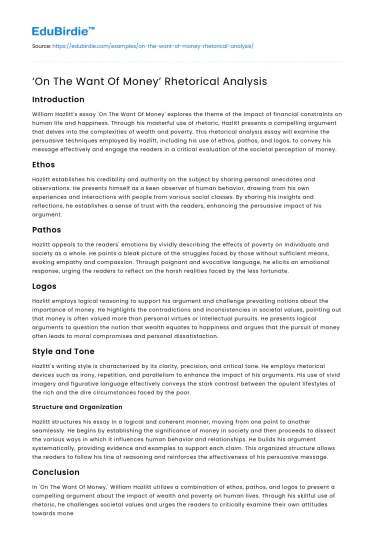Introduction
William Hazlitt's essay 'On The Want Of Money' explores the theme of the impact of financial constraints on human life and happiness. Through his masterful use of rhetoric, Hazlitt presents a compelling argument that delves into the complexities of wealth and poverty. This rhetorical analysis essay will examine the persuasive techniques employed by Hazlitt, including his use of ethos, pathos, and logos, to convey his message effectively and engage the readers in a critical evaluation of the societal perception of money.
Ethos
Hazlitt establishes his credibility and authority on the subject by sharing personal anecdotes and observations. He presents himself as a keen observer of human behavior, drawing from his own experiences and interactions with people from various social classes. By sharing his insights and reflections, he establishes a sense of trust with the readers, enhancing the persuasive impact of his argument.
Save your time!
We can take care of your essay
- Proper editing and formatting
- Free revision, title page, and bibliography
- Flexible prices and money-back guarantee
Pathos
Hazlitt appeals to the readers' emotions by vividly describing the effects of poverty on individuals and society as a whole. He paints a bleak picture of the struggles faced by those without sufficient means, evoking empathy and compassion. Through poignant and evocative language, he elicits an emotional response, urging the readers to reflect on the harsh realities faced by the less fortunate.
Logos
Hazlitt employs logical reasoning to support his argument and challenge prevailing notions about the importance of money. He highlights the contradictions and inconsistencies in societal values, pointing out that money is often valued more than personal virtues or intellectual pursuits. He presents logical arguments to question the notion that wealth equates to happiness and argues that the pursuit of money often leads to moral compromises and personal dissatisfaction.
Style and Tone
Hazlitt's writing style is characterized by its clarity, precision, and critical tone. He employs rhetorical devices such as irony, repetition, and parallelism to enhance the impact of his arguments. His use of vivid imagery and figurative language effectively conveys the stark contrast between the opulent lifestyles of the rich and the dire circumstances faced by the poor.
Structure and Organization
Hazlitt structures his essay in a logical and coherent manner, moving from one point to another seamlessly. He begins by establishing the significance of money in society and then proceeds to dissect the various ways in which it influences human behavior and relationships. He builds his argument systematically, providing evidence and examples to support each claim. This organized structure allows the readers to follow his line of reasoning and reinforces the effectiveness of his persuasive message.
Conclusion
In 'On The Want Of Money,' William Hazlitt utilizes a combination of ethos, pathos, and logos to present a compelling argument about the impact of wealth and poverty on human lives. Through his skillful use of rhetoric, he challenges societal values and urges the readers to critically examine their own attitudes towards money. Hazlitt's ability to evoke emotions, present logical reasoning, and craft his message with clarity and precision make this essay a thought-provoking and persuasive piece of literature. His insights continue to resonate today, reminding us of the complexities surrounding money and its influence on our perceptions of happiness and fulfillment.






 Stuck on your essay?
Stuck on your essay?

